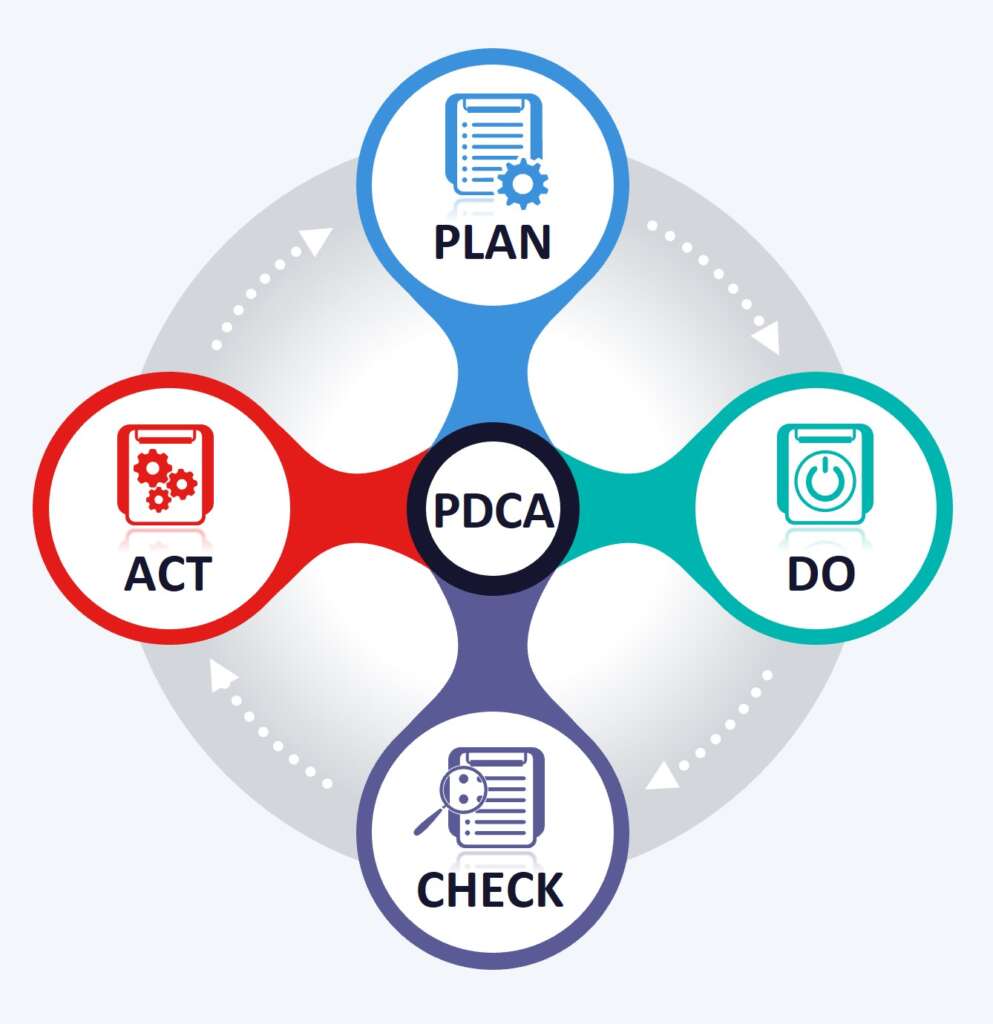
Blog
Delivering agility in a virtual world
By Mark Bassington |
In response to Covid 19, how well are you collaborating and managing your workload in this new virtual world?
Are you:
- Finding it difficult to maintain your team’s focus and delivery?
- Struggling to scale up and prioritise activities?
- Trying to do too many things or even some wrong things in an uncoordinated way?
- Trying to do too much at once and struggling to track progress?
At Future Purchasing, we have wrestled with these challenges and over the last 6 months we have introduced a number of “agile” approaches into our operating model. Whilst for many, “agile” is just a buzzword and the latest shiny new management tool, it does have some really useful tools and techniques to help manage your daily workload. We have broken this blog into 2 sections, the first related to day- to- day activity in plain English, and the second in more technical language.
Real-world example of “agile” working
Let’s examine a domestic chore that we all have to do from time to time – spring cleaning. It is a job that often gets delayed or never done at all. The reasons are usually because “I didn’t have the time to do it” or more realistically “I didn’t want to do it”. The reason for this could be that the job feels like too big a task, or you have other things to do which are higher priority, or you want to do other things that are more interesting. So, let’s consider a different approach:

Plan
You have now got 5 weeks to do the spring clean as we are likely to be in lockdown for that long at least. Let’s break the task down into shorter time periods, maybe to a week or a day, to help you to plan and focus.
Instead of thinking you have got to clean the whole house in one go, break it down into a list of rooms or even activities within rooms e.g. for your kitchen: clear out cupboards, clean the cupboards, clean the cooker, clean the fridge, etc.
Estimate roughly how many hours each activity will take to complete and allocate the appropriate time to the activities on the list.
Consider who can do the activity and allocate it accordingly to spread the workload.
Calculate how many hours are available for you to do this each week.
Do
Prioritise the activities that you want to do in week 1 and that will fit into the daily or weekly time allocated. Working in smaller activity increments and time periods is better as this will help you to feel less daunted and get things completed.
Start with the first activity in your prioritized list and complete the work. Be clear what success looks like, i.e. when is it something looks clean or tidy enough.
Finish that activity before considering starting the next one on your list. If you have some allocated time left over in that period pick another activity from the list that you are confident you can complete in the time available.
It is important we do not start something unless we are confident we can finish it. That is why it is important to break activities down into small achievable chunks. This helps us to feel better as we tick things off our list and is also a source of motivation.
Each morning you should review your priorities as they may have changed since yesterday and refine your activities to fit with the available time.
Check
At the end of the week, reflect on what you have or have not achieved and why. Think about what you could have done differently to be more effective.
Make sure you have a good weekend break.
Act
Start the next week refreshed, implement your improvements and carry on the processes above until the house is complete or you have done enough.
If you are interested in finding out how to apply “agile” in a more technical area, then please read the article below which puts this into a business perspective. We are also offering a free 60-minute consultation to the first 5 people who email their interest. Please contact: Mark Bassington, [email protected]
For the technical version please read on.
Bringing agility to your business and/or procurement processes
At Future Purchasing, we have adopted “agile” working in our approach to delivering more effective procurement performance especially in the areas of category strategy development, sourcing execution and post contract management benefits realisation. We have refocused on our customer needs/requirements to bring pace and certainty to delivery.
There are a number of key principles that we have adopted:
- Kanban: we have introduced Kanban as the core methodology for managing and tracking our work. We operate Kanban boards for each of our key business activities utilising Microsoft Planner (previously Trello www.trello.com ) as this exploits the broadest collaboration capabilities of the Microsoft 365 product set.
- User- centred design/development: we focus on end-customer or user needs to ensure they inform any product development activities we want to pursue.
- Minimum Viable Product (“MVP”) : we focus on identifying the minimum functional and non-functional requirements to develop the MVP. We get the MVP into the users’ hands as soon as possible to test and gather feedback and then iterate the product accordingly.
- Definition of Done (“DoD”): it is important to know when a product or service is “good enough” by defining the minimum acceptance criteria. It is often said that “perfect is the enemy of the good”. So, achieving the minimum acceptance criteria is vital to making progress in a rapid way.
- Resource capacity: capacity and availability are worked out based on 75% productive time allowing for comfort breaks, emails and other non-productive time. Hence, a 40-hour week would equate to 30 hours as a baseline. From this, you deduct any holidays or existing commitments such as other work which leaves you with your available capacity.
Key roles in agile working
There are three important roles when working in an agile way:
- Product owner: This is the most critical role as they will typically be a senior executive who has accountability for the area concerned. For example, if it was related to Telecomms, then the product owner may be the Head of Telecoms. They are accountable for the product/solution, its features/content, its development, marketing and delivery. They attend key meetings such as daily stand-ups and sprint retrospectives.
- Scrum master: These would typically be your category manager or sourcing lead whose role is a servant leader i.e. they do not “line manage” the team, rather they help facilitate and manage progress and the flow of activities. One of the key fundamentals in Kanban is to get the backlog activities completed in the sprint time period – the scope/activities can change but the time is fixed. The scrum master needs to ensure that individuals are progressing activities effectively and not doing too many things at the same time and therefore not finishing them. As you near completion of a sprint you need to “stop starting and start finishing”.
- Story owner : This would be the subject matter expert or resource from any relevant business function, e.g. IT, HR, Operations, etc. who is responsible for delivery of the activity, e.g. specification, demand profile, supply market research, etc. They should seek agreement to its content and definition of done from the product owner. They attend the daily stand-up and update the Kanban board to reflect progress and also attend the sprint retrospective.
Key activities in agile working
- Backlog: we operate a backlog of items for each area that records the activities that we need to deliver which are stored in the backlog as “story cards”. This is a single visible list of what we have to do which gets updated as we better understand what does and does not need to be delivered.
- Story Cards: for each activity expressed as a story card
- Where possible, the stories are expressed as user needs so “As a <user type>, I need to <insert feature/need> so that I can <state outcome>. e.g. as a sourcing manager, I need the demand profile, so that I can provide potential business volumes and opportunities in the tender document.
- We also identify the story card owner, key sub activities, dependencies and estimated time to deliver in hours.
- Any relevant tools & guidance are linked to the card.
- Stories are broken down into activities of not more than 4 hours if possible. The smaller the size of the stories the better as this improves flow.
- Story Card Estimating : the story card owner estimates the time it will take to deliver it using hours as the unit of measure. This is based on actual development time and not the elapsed time. The time is recorded on the card which helps over time to track our estimating effectiveness and efficiency improvements.
- Delivery Sprints: We work in one-week periods as this focuses our teams on what needs to be done in the short-term and helps with prioritisation. At the start of the sprint, we have a sprint planning meeting, and we hold daily stand-ups and a retrospective sprint at the end of the sprint. A “scrum master” should be appointed for the team: they will manage the operation of the sprint.
Key meetings in agile working
There are three key types of meetings or “ceremonies” that are mandatory and manage each Kanban board – (i) sprint planning at the outset, (ii) daily stand-ups and (iii) sprint retrospectives. These are outlined below along with the key activities:
- Sprint planning : this is a collaborative meeting led by the scrum master prior to the start of a sprint to identify priority items from the backlog to be delivered in the next sprint period, story card ownership and available resource capacity. This meeting sets the objective for the sprint and gains commitment from the participants regarding what they are going to deliver and to ensure with the team that it is realistic and achievable.
- Daily stand-ups: led by the scrum master these are short 15-30 minute focused progress reviews ideally held at the start of the day based on the Kanban board. All participants provide an update on their activities due to be completed the previous day and those in progress that need additional support. Follow up actions on these are taken offline and facilitated by the scrum master straight after the stand-up.
- Sprint retrospective: takes place at the end of each sprint and is facilitated by the scrum master and attended by the entire team. This is a review of what was achieved and not achieved and why. It also identifies the reasons and what we could do differently next time to improve team effectiveness. It should take a maximum of one hour.
Following delivery of the product/service, the product owner is responsible for through life management of the product/solution. They should continuously improve it based on evolving user/customer needs obtained through regular feedback mechanisms and also decide when the product/solution is no longer needed or superseded and therefore retired.
Summary
The overall result of adopting these practices is that we the following:
- Elapsed time savings of 25-33% bringing delivery of benefits earlier, and category strategy development time reduced by up to 4 weeks.
- Reduction in active time of c20% through prioritising only what we have to do, and being clear on the minimum required level of quality.
- Improvement in quality of products as we only (initially) deliver what the stakeholder/customer wants against pre-agreed acceptance criteria, then iterate thereafter based on feedback.
- Completion of more activities to time by breaking them down and rigorously managing work in progress and completion via daily stand-ups.
- Continuous improvement in our teamwork, solutions and effectiveness.
If you would like to discuss how agile techniques can be brought into your procurement teams (Operations, Sourcing, Category & Supplier Management) to improve delivery of high criticality Covid 19 activities and/or business as usual stakeholder engagement, delivery effectiveness, quality and certainty, please contact: Mark Bassington
Further reading
Blog post: Lessons for Category Managers from 2021

Director Public Sector
Principal Consultant in Consulting & Delivery
20 years procurement experience in line management and
consulting roles.
Previous employment: London Underground, British Energy,
QP Group, PwC, Exult.
Education: MCIPS, MBA Strategic Procurement Management, University of Birmingham.
CIPS: member.
Further Reading

Blog
Insights from Procurecon 2019; sustainability, agility and knowledge
23/10/2019
Read More

Case study
At AstraZeneca the foundations of category management are built on stakeholder engagement
07/11/2023
Read More

Case study
Mark Smith interview – A lean category management model is at the heart of procurement at bp
08/02/2024
Read More